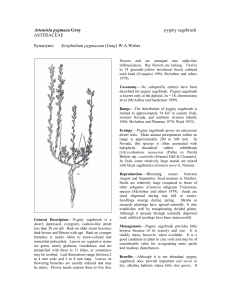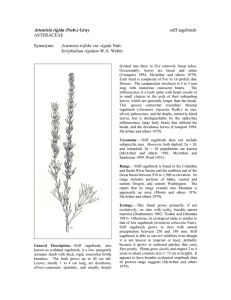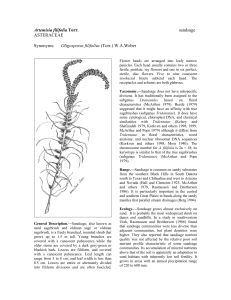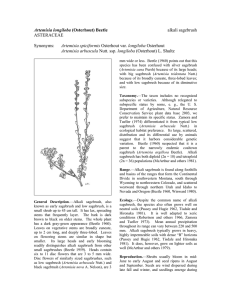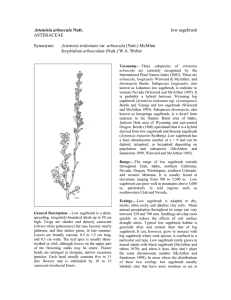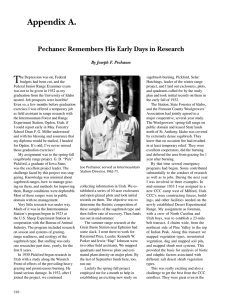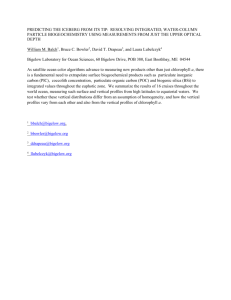Artemisa bigelovii Bigelow sagebrush ASTERACEAE
advertisement
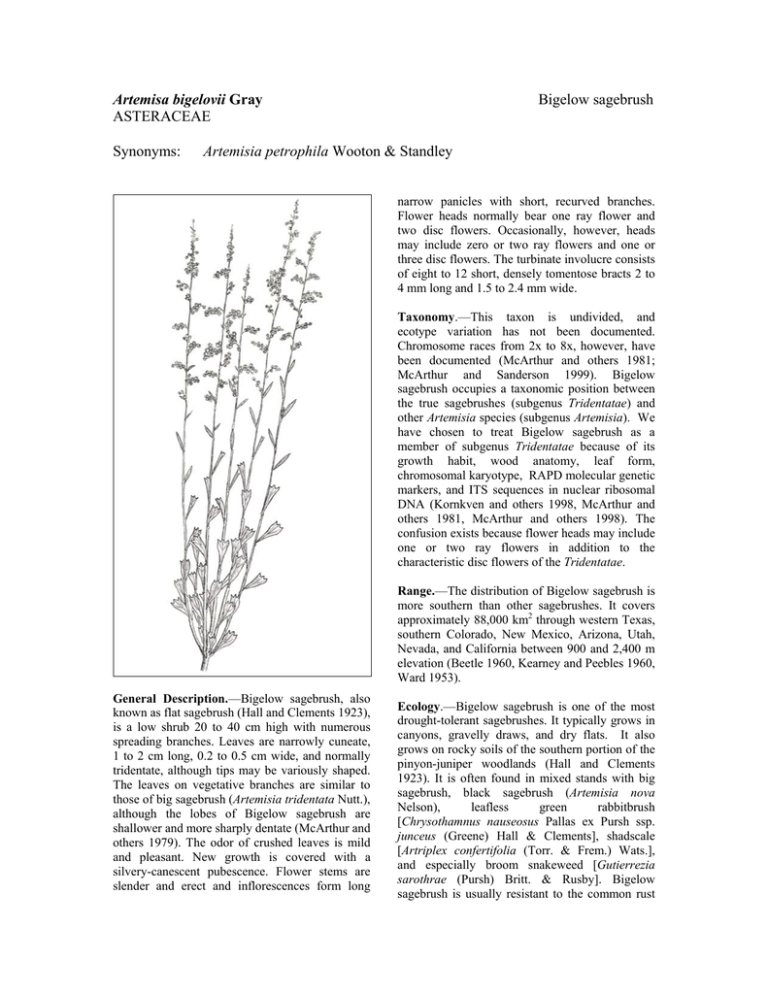
Artemisa bigelovii Gray ASTERACEAE Synonyms: Bigelow sagebrush Artemisia petrophila Wooton & Standley narrow panicles with short, recurved branches. Flower heads normally bear one ray flower and two disc flowers. Occasionally, however, heads may include zero or two ray flowers and one or three disc flowers. The turbinate involucre consists of eight to 12 short, densely tomentose bracts 2 to 4 mm long and 1.5 to 2.4 mm wide. Taxonomy.—This taxon is undivided, and ecotype variation has not been documented. Chromosome races from 2x to 8x, however, have been documented (McArthur and others 1981; McArthur and Sanderson 1999). Bigelow sagebrush occupies a taxonomic position between the true sagebrushes (subgenus Tridentatae) and other Artemisia species (subgenus Artemisia). We have chosen to treat Bigelow sagebrush as a member of subgenus Tridentatae because of its growth habit, wood anatomy, leaf form, chromosomal karyotype, RAPD molecular genetic markers, and ITS sequences in nuclear ribosomal DNA (Kornkven and others 1998, McArthur and others 1981, McArthur and others 1998). The confusion exists because flower heads may include one or two ray flowers in addition to the characteristic disc flowers of the Tridentatae. Range.—The distribution of Bigelow sagebrush is more southern than other sagebrushes. It covers approximately 88,000 km2 through western Texas, southern Colorado, New Mexico, Arizona, Utah, Nevada, and California between 900 and 2,400 m elevation (Beetle 1960, Kearney and Peebles 1960, Ward 1953). General Description.—Bigelow sagebrush, also known as flat sagebrush (Hall and Clements 1923), is a low shrub 20 to 40 cm high with numerous spreading branches. Leaves are narrowly cuneate, 1 to 2 cm long, 0.2 to 0.5 cm wide, and normally tridentate, although tips may be variously shaped. The leaves on vegetative branches are similar to those of big sagebrush (Artemisia tridentata Nutt.), although the lobes of Bigelow sagebrush are shallower and more sharply dentate (McArthur and others 1979). The odor of crushed leaves is mild and pleasant. New growth is covered with a silvery-canescent pubescence. Flower stems are slender and erect and inflorescences form long Ecology.—Bigelow sagebrush is one of the most drought-tolerant sagebrushes. It typically grows in canyons, gravelly draws, and dry flats. It also grows on rocky soils of the southern portion of the pinyon-juniper woodlands (Hall and Clements 1923). It is often found in mixed stands with big sagebrush, black sagebrush (Artemisia nova Nelson), leafless green rabbitbrush [Chrysothamnus nauseosus Pallas ex Pursh ssp. junceus (Greene) Hall & Clements], shadscale [Artriplex confertifolia (Torr. & Frem.) Wats.], and especially broom snakeweed [Gutierrezia sarothrae (Pursh) Britt. & Rusby]. Bigelow sagebrush is usually resistant to the common rust diseases and insect galls common to other Tridentatae taxa (Beetle 1960). It is, however, susceptible to wilt disease (Nelson and Krebill 1981). It grows in areas that usually receive 250 to 400 mm of annual precipitation. Reproduction.—Flowering occurs from August to October and seeds mature during the following months. Seeds are wind dispersed in the fall and winter, and seedlings emerge in spring. Seeds are among the smallest of sagebrush seeds, about 5.5 million cleaned seeds per kg (Meyer 2003). Seedlings grow rapidly, and young shrubs are robust and vigorous. Plants appear to have good drought tolerance, even as seedlings. Direct seeding has been limited to experimental plantings. Seeded shrubs grow well and natural spread normally occurs around the parental plant, suggesting that Bigelow sagebrush can be successfully seeded. Management.—Bigelow sagebrush is palatable to livestock and game throughout its distribution. Its twigs are less woody, aromatic, and bitter than most species within the big sagebrush complex (Hall and Clements 1923). In addition, Bigelow sagebrush is more grazing tolerant than most other sagebrushes. These shrubs, however, are generally scattered, and extensive stands are found only near the Four Corners area of Utah, Arizona, New Mexico, and Colorado. Benefits.—Bigelow sagebrush adds biological diversity to shrub communities throughout the Southwestern United States. This species improves soil stability and reduces erosion. It also provides palatable forage for livestock and wildlife and adds structural diversity to the landscape. References Beetle, A.A. 1960. A study of sagebrush: the section Tridentatae of Artemisia. Bulletin 368. Agricultural Experiment Station, University of Wyoming, Laramie, WY. 83 p. Hall, H.M. and F.E. Clements. 1923. The phylogenetic method in taxonomy, the North American species of Artemisia, Chrysothamnus, and Atriplex. Publication 326. Carnegie Institution of Washington, Washington, DC. 355 p. Kearney, T.H. and R.H. Peebles. 1960. Arizona flora, 2nd edition. University of California Press, Berkeley, CA. 1,065 p. Kornkven, A.B., L.E. Watson, and J.R. Estes. 1998. Phylogenetic analysis of Artemisia section Tridentatae (Asteraceae) based on sequences from the internal transcribed spacers (ITS) of nuclear ribosomal DNA. American Journal of Botany 85: 1787-1795. McArthur, E.D., A.C. Blauer, A.P. Plummer, and R. Stevens 1979. Characteristics and hybridization of important intermountain shrubs. III. Sunflower family. Research Paper INT-220. U.S. Department of Agriculture, Forest Service Intermountain Forest and Range Experiment Station, Ogden, UT. 82 p. McArthur, E.D., C.L. Pope, and D.C. Freeman. 1981. Chromosomal studies of subgenus Tridentatae of Artemisia: evidence for autopolyploidy. American Journal of Botany 68: 589-605. McArthur, E.D. and S.C. Sanderson. 1999. Cytogeography and chromosome evolution of subgenus Tridentatae of Artemisia (Asteraceae). American Journal of Botany 86: 1754-1775. McArthur, E.D., R. Van Buren, S.C. Sanderson, and K.T. Harper. 1998. Taxonomy of Sphaeromeria, Artemisia, and Tanacetum (Compositatae, Anthemideae) based on randomly amplified polymorphic DNA (RAPD). Great Basin Naturalist 58: 1-11. Meyer, S.E. 2003. Artemisia. In: T.F. Bonner and R.G. Nisley, eds. Woody plant seed manual. http://www.wpsm.net 12 p. Nelson, D.L. and R.G. Krebill. 1981. A sagebrush wilt disease of unknown origin. Great Basin Naturalist 41: 184-191. Ward, G.H. 1953. Artemisia, section Seriphidium, in North America. A cytotaxonomic study. Contributions from the Dudley Herbarium 4: 155-205. _________________________________________ E. Durant McArthur and Jeffrey R. Taylor, Research Geneticist and Biological Technician, U.S. Department of Agriculture, Forest Service, Rocky Mountain Research Station, Shrub Sciences Laboratory, Provo, UT 84606-1856
